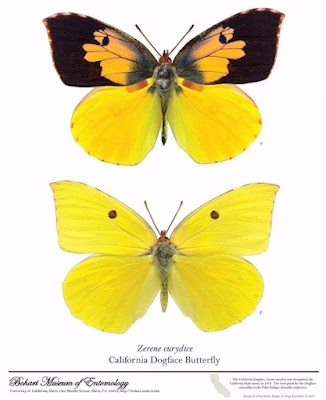
Bohart Museum of Entomology salutes the dogface butterfly

|
|
This poster from the Bohart Museum of Entomology
shows the male and female California dogface butterflies.
The poster is the work of Fran Keller and Greg Kareofelas. |
When you saw the top headline, did you remember the name of the California's state insect? Most of us learned that in 4th grade, along with the state flower (California poppy, of course) and the state bird (California quail). It's the California dogface butterfly ( Zerene eurydice ).
Unlike some of the other state symbols, the dogface butterfly has been the state insect only since 1972. (The California redwood was designated the state tree in 1937. The poppy earned its title in 1903.)
The Bohart Museum of Entomology, on the UC Davis campus, will celebrate those 50 years of butterfly celebrity with a family-friendly open house this Saturday from 1 to 4 p.m. It's hardly a coincidence that the California dogface butterfly is part of the Bohart's logo . (The male butterfly has the dog head outline in its peach and black upper wing markings; the female is all yellow with a black spot on the upper wings.)
The butterfly, also called "the flying pansy" for its markings, is endemic to California. It can be found from San Diego to Sonoma County, mostly in foothills or mountain locations, but a major breeding ground is in Auburn, in the Shutamul Bear River Preserve , which is maintained by the Placer Land Trust. According to a U.S. Forest Service information page on the butterfly, its larval stage (caterpillar) feeds on the leaves of the false indigo plant, while the adults feed primarily on flower nectar from plants of the Brassicaceae (mustard) family. It's an important pollinator in its native region.
The impetus for the butterfly's inclusion in California state officialdom came from a 4th-grade class in Fresno, at Dailey Elementary School. Teachers and students persuaded then-Assemblyman Ken Maddy to be author of the bill. Then-Gov. Ronald Reagan signed the bill into law on July 28, 1972.
The Bohart Museum is rarely open on the weekend, so this event is a great chance for families and insect fans of all ages to visit. The museum is in Room 1124 of the Academic Surge Building, 455 Crocker Lane, UC Davis Main Campus. The nearest intersection is LaRue Road and Crocker Lane. See the map here . Campus parking is free on weekends.
For more information on how UC Davis entomologists discovered the butterfly's Auburn breeding grounds, read this post from The Bug Squad , a blog by Kathy Keatley Garvey, UC Davis communications specialist.
-- Kathy Morrison
P.S. If you visit the State Fair over the next two weeks (it opens Friday), look for the California dogface butterfly images on the monorail cars.
Comments
0 comments have been posted.Sacramento Digs Gardening to your inbox.
Sites We Like
Garden Checklist for week of April 21
This week there’s plenty to keep gardeners busy. With no rain in the immediate forecast, remember to irrigate any new transplants.
* Weed, weed, weed! Get them before they flower and go to seed.
* April is the last chance to plant citrus trees such as dwarf orange, lemon and kumquat. These trees also look good in landscaping and provide fresh fruit in winter.
* Smell orange blossoms? Feed citrus trees with a low dose of balanced fertilizer (such as 10-10-10) during bloom to help set fruit. Keep an eye out for ants.
* Apply slow-release fertilizer to the lawn.
* Thoroughly clean debris from the bottom of outdoor ponds or fountains.
* Spring brings a flush of rapid growth, and that means your garden is really hungry. Feed shrubs and trees with a slow-release fertilizer. Or mulch with a 1-inch layer of compost.
* Azaleas and camellias looking a little yellow? If leaves are turning yellow between the veins, give them a boost with chelated iron.
* Trim dead flowers but not leaves from spring-flowering bulbs such as daffodils and tulips. Those leaves gather energy to create next year's flowers. Also, give the bulbs a fertilizer boost after bloom.
* Pinch chrysanthemums back to 12 inches for fall flowers. Cut old stems to the ground.
* Mulch around plants to conserve moisture and control weeds.
* From seed, plant beans, beets, cantaloupes, carrots, corn, cucumbers, melons, radishes and squash.
* Plant onion sets.
* In the flower garden, plant seeds for asters, cosmos, celosia, marigolds, salvia, sunflowers and zinnias.
* Transplant petunias, zinnias, geraniums and other summer bloomers.
* Plant perennials and dahlia tubers for summer bloom.
* Mid to late April is about the last chance to plant summer bulbs, such as gladiolus and tuberous begonias.
* Transplant lettuce seedlings. Choose varieties that mature quickly such as loose leaf.